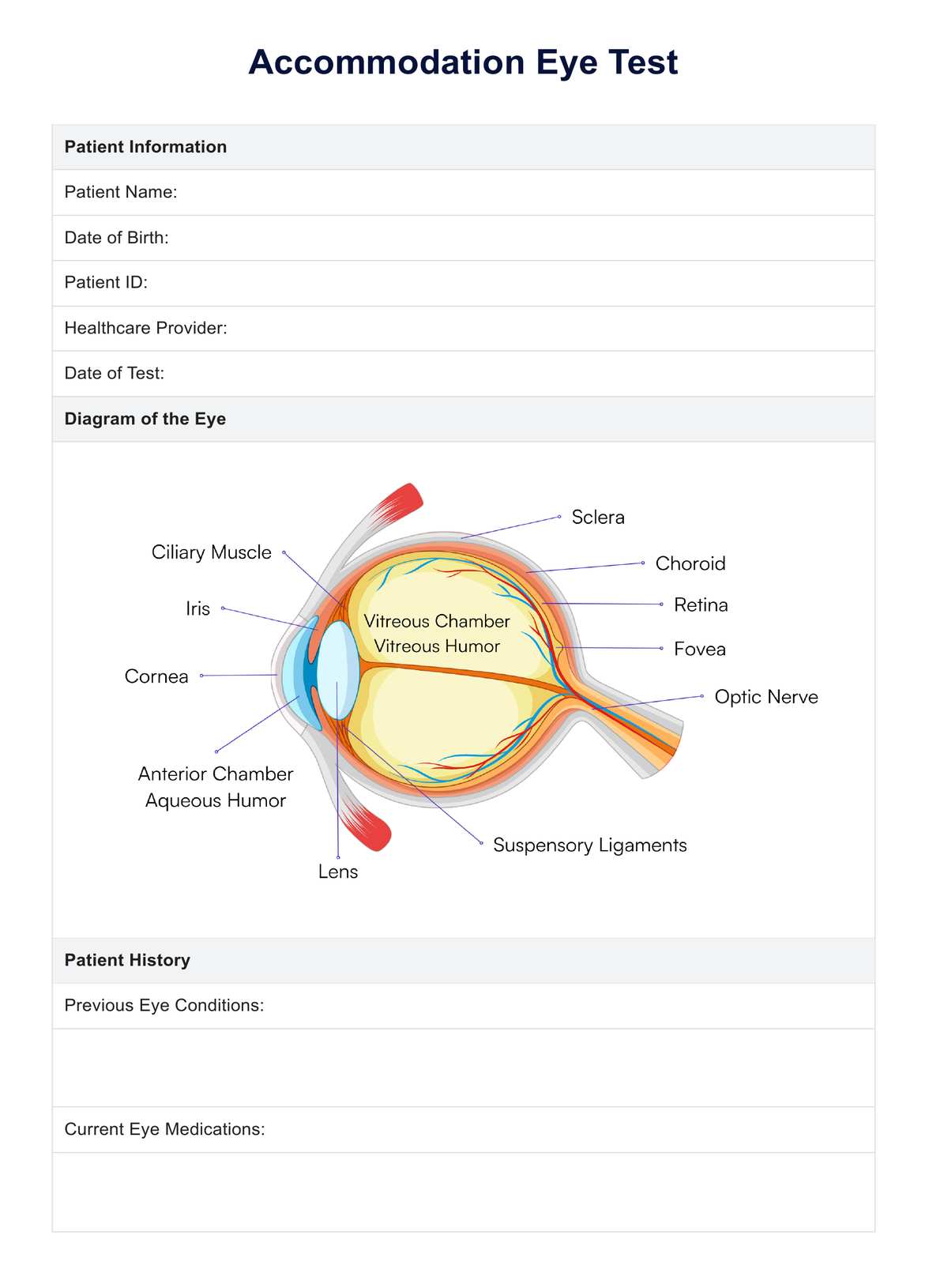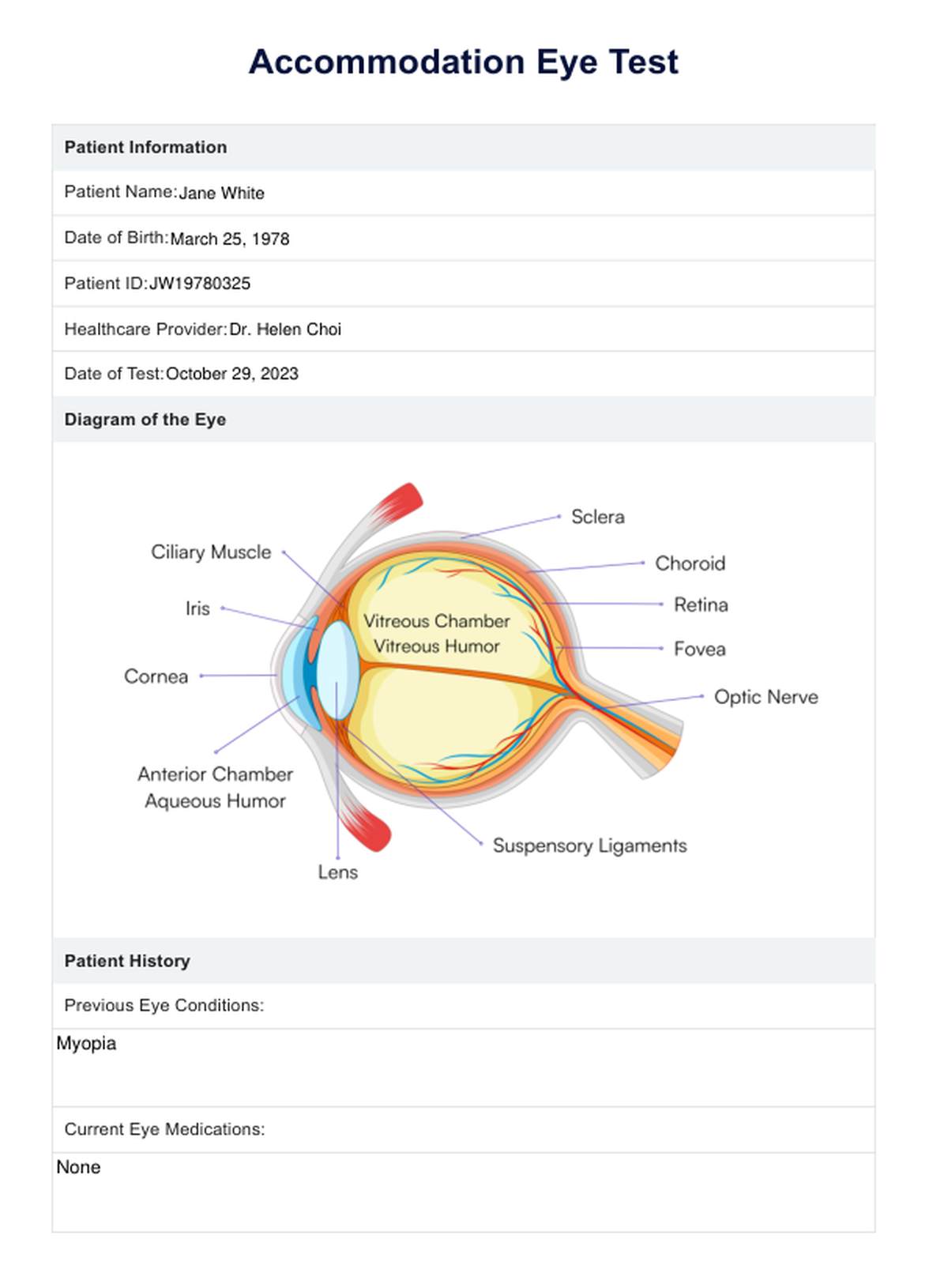Accommodation Eye Test
Learn about the Accommodation Eye Test, PERRLA, and signs of accommodative insufficiency in our comprehensive eye health guide.


The importance of the accommodation reflex
The accommodation reflex is crucial for clear vision across all distances. It underpins everyday tasks like reading, writing, and using digital devices. By enabling the eye to adjust its lens shape for optimal focus, this reflex ensures sharp vision for both near and distant objects.
Moreover, the accommodation reflex is a key indicator of overall eye health, with any impairments potentially highlighting underlying eye conditions or neurological disorders. Therefore, assessing this reflex is a critical part of comprehensive eye examinations.
As we age, our eyes’ ability to switch focus between near and far objects, known as accommodation, decreases due to presbyopia. This condition, typically starting in the early to mid-40s, is caused by the lens becoming less flexible, making it difficult to focus on close objects.
Presbyopia leads to symptoms such as difficulty reading small print, the need to hold reading materials at a distance, and eye strain or headaches after close work. Many require reading glasses, bifocals, or other corrective solutions to maintain clear near vision.
Accommodation Eye Test Template
Accommodation Eye Test Example
Understanding accommodative insufficiency
Accommodative insufficiency is an eye disorder characterized by the eye’s inability to adequately adjust its focusing power to maintain clear vision for near tasks. This condition is often related to the ciliary muscle’s reduced ability to change the lens’s shape inside the eye, which is necessary for focusing on closer objects.
Some symptoms include:
- Difficulty focusing on near objects or reading material, which may become blurry.
- Eye strain and fatigue, especially during tasks that require sustained near vision, such as reading or using a computer.
- Headaches often occur after prolonged periods of close work.
- Double vision when looking at close objects.
- Avoidance of reading or other near tasks due to discomfort.
- Transient blurred vision sometimes occurs when shifting focus from near to distant objects or vice versa.
These symptoms can significantly impact daily activities, particularly those that involve close-up work, leading to decreased productivity and quality of life. This is often diagnosed through a comprehensive eye examination, including specific tests to evaluate the eyes’ focusing ability.
What is an Accommodation Eye Test?
The Accommodation Eye Test, also known as the PERRLA test, is an integral examination used to assess the eyes' ability to focus on near objects and their response to light. It offers insights into the neurological functioning of the pupils and eye movements. PERRLA stands for "Pupils are Equal, Round, and Reactive to Light and Accommodation," which highlights the multifaceted nature of this assessment.
Here’s a breakdown of what the PERRLA test assesses:
- Pupils equal: Examines whether the pupils are of equal size, indicating normal neurological function.
- Round: Assess if the pupils maintain a perfectly round shape, as irregularities may suggest underlying issues.
- Reactive to light: Evaluates the pupils' constriction and dilation in response to light, which is crucial for identifying potential reflex problems.
- Accommodation: Focuses on the eyes' capability to adjust focus on near objects, involving pupil constriction and the converging movement of the eyes towards each other.
An eye doctor typically conducts this test using tools emitting bright light, such as a penlight or ophthalmoscope. They use these tools to observe how the pupils react to light and accommodate for near vision. Abnormal results can hint at various conditions, such as nerve damage or brain injuries, and may lead to further medical investigation.
The PERRLA eye test is also vital for diagnosing issues with near vision and understanding conditions affecting the eye's focusing ability. It is often conducted alongside other vision tests as part of a comprehensive eye examination.
How to conduct the accommodation of eye test?
Conducting a comprehensive eye exam involves assessing the eye’s ability to focus on nearby objects. Here’s a general outline of how the test is performed:
Preparation
Before starting the test, ensure the environment is well-lit and the patient is seated comfortably. Explain the procedure to the patient to alleviate concerns and ensure they understand what is expected during the test.
Choosing the target
Select a small object with fine details, such as a pen or a reading card with small print, to serve as the focus target. This helps accurately assess the eye’s ability to focus on a nearby object.
Testing distance
Begin with the target positioned about an arm’s length away from the patient’s eyes. This distance serves as the starting point for the assessment.
Observing the eyes
Instruct the patient to focus on the target as it moves nearer, observing key signs of accommodation like pupil constriction and eye convergence.
Identifying the near point of convergence
Continue moving the object closer until the patient reports blurriness, a loss of convergence, or when accommodation is observed. The closest point at which the patient can keep the target in clear focus without experiencing double vision is the near point of convergence.
Repeating the test
For accuracy, it may be necessary to repeat the test several times. This is particularly important if testing children or if there are inconsistencies in the patient’s responses.
Assessing the results
Evaluate the patient’s performance against normal values for their age group. A significant difference from expected norms may indicate defects or other focusing problems.
This test should be part of a comprehensive eye exam. It should be conducted by an eye doctor, such as an optometrist or ophthalmologist, to ensure accurate results and proper interpretation.
Commonly asked questions
The frequency of eye examinations can vary depending on age, health conditions, and risk factors for eye diseases. Generally, it's recommended that adults have a comprehensive eye exam every 1 to 2 years. Children should have their vision checked at six months, three years, before first grade, and regularly during school. People over 60 should have annual exams. Those with specific risk factors, such as diabetes, a family history of glaucoma, previous eye injuries, or who wear contact lenses, may need more frequent exams as advised by their eye care professional.
An eye care professional will observe pupils' responses to focusing on a nearby object to check pupils for accommodation. The examiner will move an object, like a pen or a finger, towards the patient's nose and observe the pupils. The normal response is for the pupils to constrict (become smaller) and for the eyes to converge as the object comes closer. This tests the "accommodation reflex," which is the eye's ability to adjust its lens shape to focus on near objects.
Normal accommodation of the eye refers to the eye's ability to change its focus from distant to near objects. This is achieved by the lens inside the eye changing its shape. For young adults, the average maximum accommodation is around 14 to 16 diopters, which means they can focus on objects as close as six to seven centimeters from the eye. However, this ability diminishes with age, a condition known as presbyopia, starting around the age of 40 to 50, reducing the eye's ability to focus on close objects.











































































































